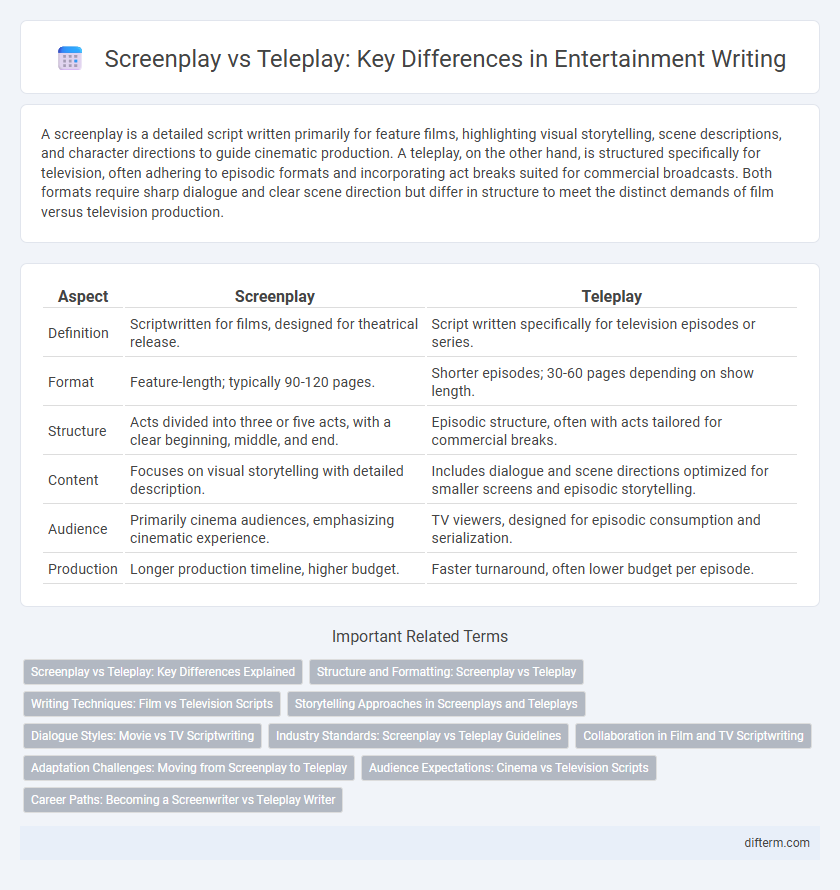A screenplay is a detailed script written primarily for feature films, highlighting visual storytelling, scene descriptions, and character directions to guide cinematic production. A teleplay, on the other hand, is structured specifically for television, often adhering to episodic formats and incorporating act breaks suited for commercial broadcasts. Both formats require sharp dialogue and clear scene direction but differ in structure to meet the distinct demands of film versus television production.
Table of Comparison
| Aspect | Screenplay | Teleplay |
|---|---|---|
| Definition | Scriptwritten for films, designed for theatrical release. | Script written specifically for television episodes or series. |
| Format | Feature-length; typically 90-120 pages. | Shorter episodes; 30-60 pages depending on show length. |
| Structure | Acts divided into three or five acts, with a clear beginning, middle, and end. | Episodic structure, often with acts tailored for commercial breaks. |
| Content | Focuses on visual storytelling with detailed description. | Includes dialogue and scene directions optimized for smaller screens and episodic storytelling. |
| Audience | Primarily cinema audiences, emphasizing cinematic experience. | TV viewers, designed for episodic consumption and serialization. |
| Production | Longer production timeline, higher budget. | Faster turnaround, often lower budget per episode. |
Screenplay vs Teleplay: Key Differences Explained
Screenplays are written for films, emphasizing visual storytelling and cinematic techniques, while teleplays are crafted specifically for television episodes, focusing on dialogue and episodic structure. Screenplays typically contain detailed scene descriptions and camera directions, whereas teleplays prioritize scripted dialogue and act breaks tailored for commercial TV formats. Understanding screenplay vs teleplay distinctions is crucial for writers navigating film versus television production processes.
Structure and Formatting: Screenplay vs Teleplay
Screenplays typically follow a three-act structure with detailed scene descriptions and focus on visual storytelling, formatted with scene headings, action lines, and dialogue centered on the page. Teleplays often use a four-act or five-act structure suited for commercial breaks, featuring act breaks explicitly marked and formatting tailored to multi-camera setups or single-camera productions. Differences in formatting reflect the storytelling needs of film versus television, with teleplays emphasizing pacing and act breaks critical for episodic content.
Writing Techniques: Film vs Television Scripts
Screenplays prioritize visual storytelling with detailed scene descriptions and camera directions to guide film production, emphasizing a linear narrative flow. Teleplays focus on dialogue and character interactions suited for episodic television, incorporating act breaks and pacing designed for commercial interruptions. Writing techniques diverge as screenplays demand cinematic imagery while teleplays structure scripts to fit broadcast timing and multi-episode arcs.
Storytelling Approaches in Screenplays and Teleplays
Screenplays prioritize visual storytelling with detailed scene descriptions and cinematic techniques that leverage camera movements and editing to convey plot and emotion. Teleplays emphasize dialogue and character interactions, designed for episodic television formats that rely on consistent character development and story arcs across episodes. Both forms utilize structured acts but differ in pacing, with teleplays often incorporating cliffhangers to maintain audience engagement over multiple episodes.
Dialogue Styles: Movie vs TV Scriptwriting
Movie screenplay dialogue often emphasizes cinematic brevity and subtext, aiming to convey character emotions and plot through concise, impactful lines suited for visual storytelling. Teleplay dialogue typically includes more extended exchanges and episodic hooks to maintain viewer engagement across multiple episodes or scenes. TV scriptwriting prioritizes character-driven conversations that develop over time, contrasting with the more self-contained, thematic dialogue found in film scripts.
Industry Standards: Screenplay vs Teleplay Guidelines
Screenplay and teleplay formats follow distinct industry standards tailored to their respective mediums. Screenplays prioritize visual storytelling with detailed scene descriptions and less emphasis on dialogue formatting, suited for films, while teleplays adhere to stricter act structures and precise dialogue cues designed for episodic television production. Understanding these formatting differences is essential for writers aiming to meet studio expectations and production workflows in both film and television industries.
Collaboration in Film and TV Scriptwriting
Collaboration in film and TV scriptwriting differs significantly between screenplays and teleplays due to the production processes involved. Screenplays often undergo revisions with input from directors, producers, and actors during film shoots, while teleplays require writers to work closely with showrunners and production teams to meet tight episodic deadlines and maintain story continuity across multiple episodes. Effective collaboration in both formats enhances narrative coherence and character development, crucial for engaging audiences in visual storytelling.
Adaptation Challenges: Moving from Screenplay to Teleplay
Adapting a screenplay into a teleplay requires careful consideration of episodic structure and time constraints unique to television formats. Writers must condense or expand scenes to fit commercial breaks while maintaining narrative coherence and character development. The shift demands balancing visual storytelling with dialogue-driven pacing to engage audiences within shorter, segmented time slots.
Audience Expectations: Cinema vs Television Scripts
Screenplays for cinema typically demand a more immersive, visually-driven narrative designed to captivate audiences in a single sitting, emphasizing cinematic elements like detailed scene descriptions and expansive settings. Teleplays, crafted for television, prioritize episodic structure and character development to maintain viewer engagement over multiple episodes, often incorporating cliffhangers and tighter dialogue. Audience expectations in cinema call for a complete, high-impact story experience, while television viewers anticipate ongoing plot progression and character arcs that unfold gradually.
Career Paths: Becoming a Screenwriter vs Teleplay Writer
Screenwriters typically pursue careers in film, crafting scripts for movies with a focus on visual storytelling and cinematic pacing, often requiring knowledge of screenplay structure and film production processes. Teleplay writers specialize in television, developing episodic content that demands expertise in character development over multiple episodes, tight dialogue, and adherence to network formats. Both career paths involve collaboration with producers and directors but differ significantly in project scope, timelines, and industry conventions.
screenplay vs teleplay Infographic

 difterm.com
difterm.com